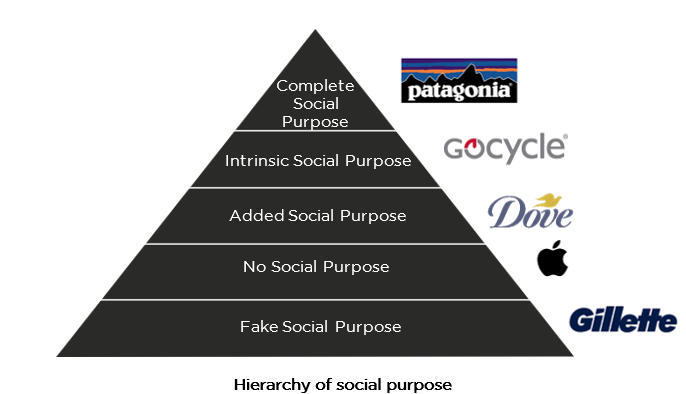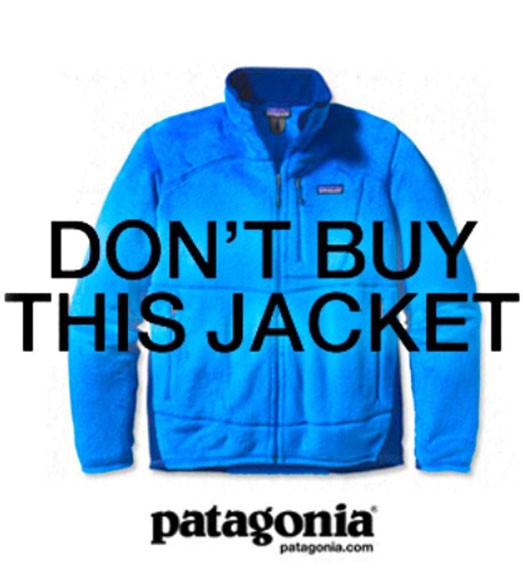


The problem with purpose - exploding the myth of brand purpose

It’s become very confusing. And not much is being done it seems to uncomplicate it. But I will try. My belief is that the subject has become confusing through a problematic combination of: lack of rigorous analysis, big buck brands that are looking for a hedge against criticism, and groupthink.
Working on building brands at Pull with clients day in and day out, we feel a need to pilot our clients around these difficult shoals in an intellectually rigorous but practical way. We do this so owners can feel better about their brand, and yet be able to look themselves in the mirror and still feel they are being honest with themselves and everyone else. The same has to go for us!
Contrary to what you might see in much of the marketing press these days, Purpose is not binary. There are 50 shades of purpose, but to make things simple we have identified five. We'll come on to that.
Better purpose doesn’t have to mean social purpose
Who hasn’t seen Simon Sinek’s ‘Why?’ speech? OK nobody. That’s handy. The point he makes is that people are most motivated by brands that are driven by something noble. Apple are driven by the noble idea of ‘doing things differently’ – and it’s not just an aspiration, that’s generally what they do too. So not unreasonably, Sinek holds them up as a paragon of ‘Purpose’. However, I would argue by our definition – we will come to it – Apple have no social purpose.
So the first thing we can deduce is that it is possible to have an inspiring purpose that your competitors can only aspire to – with no social purpose. People will flock to be employees and customers. Oh, and you might also become the most valuable brand in the history of the world – with no social purpose.
You can improve your purpose by finding a better one
People love the world’s greatest folding electric bike - Gocycle with a passion. So they should. Founder Richard Thorpe left a dream job at McLaren Cars to re-invent the wheel (check it out) and improve on the idea of a bicycle – both things they said couldn’t be done. But his passion didn’t shine through to the way the brand was positioned.
So when Pull created a Brand Blueprint™ for him we re-defined the brand’s purpose as: “Because the world deserves a better bike”. This is 100% authentically what drives Richard, certainly more than “Becoming a millionaire”. But with the newly defined purpose he had something to inspire staff and buyers with. This purpose is taught as part of every new employee’s induction, informed Gocycle’s brand positioning and underpins their campaigning.
And when online music retailer Andertons came to us for a re-brand. They weren’t really sure a retailer could even be a brand – not a ‘real’ one anyway, let alone have a compelling mission.
But they already had one. As part of creating their Brand Blueprint™ we interviewed staff and customers. Something hit us almost immediately. All their staff were musicians. All their customers reported that the first thing Andertons’ staff talked about was playing an instrument – (to paraphrase Simon Sinek) they just ‘sold a lot of instruments as a result’.
So ‘Making Musicians Since 1964’ was born. Did Andertons change their operation the day after launching their new brand? Not at all, but they didn’t need to. Pull merely uncovered their existing purpose. Did their staff feel much better about the brand they worked for? And did customers (who had already complained that the brand didn’t look much like the brand they loved) feel even better about the new brand? You bet.
So to re-cap. Purpose matters (and I’m not talking about social purpose). You and your brand will do better if you are driven by something beyond ‘making money’. You will inspire staff first (essential order!) and your staff and your proposition will inspire customers. Even if you don’t think you are purpose-driven – take a look – you might find you are more so than you thought.
Social Purpose is another thing – but not always
The biggest error made around purpose is to muddle brand purpose and social purpose. They can be one and the same thing, but you must be able to recognise when that is – and isn’t – the case.
So let’s look further at social purpose. The way Pull works we make a quite separate analysis of a brand’s social purpose. We ask two questions which allow us to plot brands on 2 axes. ‘Is there a societal benefit in this brand?’ and ‘What proximity does that societal benefit have to the brand function?
Intrinsic Purpose
Let’s test those two brands that Pull worked with. Does society benefit from a better bike? Especially if that brand lobbies around the world for better cycling infrastructure and pays its staff to bike to work – absolutely yes. Is that societal benefit intrinsic to the brand’s function? Totally.
Does the planet benefit if more people play music? You would be hard-hearted to say ‘no’. Is that benefit intrinsic to a brand that makes musicians? Surely.
If you aren’t familiar with these two smaller brands and want to see Intrinsic purpose in action – check out Toms. Toms was born around the idea that for every shoe purchased, one pair would be given to a child in need. The brand functions to achieve that as well as sell cool shoes. If you took the donation aspect away from the brand it would no longer be intrinsic.
The full Patagonia
Apparently, all hypotheses should be tested to their limit. The story of Patagonia has been well told.
This was Patagonia’s 2011 Black Friday ad. The message was ‘rein-in with the rampant consumerism and repair what you’ve got.’
Patagonia arguably exist to save the planet – literally. In fact like some other enlightened folks – they are thinking beyond ‘save’ to repair the planet – which obviously fits in rather well with their overall philosophy. Patagonia is a commercial operation, but only in a way that is truly subservient to their purpose. So their societal and functional purpose are 100% aligned. They are the almost unique example of ‘Complete Social Purpose’ in our model.
Added Social Purpose
If you keep up to date with the marketing press, then one house of brands crops up a lot. Unilever. Australian marketing guru Mark Ritson has already taken issue with some of the thinking at Unilever. In response to a post by their president of Europe Hanneke Faber who declared ‘The Brand Manager is Dead. . . Long Live the Brand Activist’ Ritson wrote:
“A clumsy aspect of all the tiresome, purpose-driven marketers that cloud the current airwaves is their totalitarian prescription that you must have a purpose or you will not succeed. Purpose is certainly one of the ways you can add meaning to your brand and thus grow, but it is not the only path to that outcome.”
While I generally agree with Ritson’s view on purpose (‘it’s really positioning’) it was his opinion on Unilever that helped Pull define the distinction between brand purpose and social purpose. I think the paragraph above is easier to understand if your read ‘social purpose’ for purpose. In our experience, all brands should have purpose, they should also consider what they can offer in terms of social purpose. But very importantly – they should consider whether that social purpose is intrinsic.
This is essentially where Unilever are at. The problem is that they don’t seem to know it. Their paradigm is not Brand Purpose and Social Purpose, but ‘authentic’ and ‘fake’ purpose. The problem is that model doesn’t work.
Unilever are keen to be seen as authentic talking about purpose. CEO Alan Jope has tried to distinguish between the ‘true’ purpose of their brands and those that are muddying the waters by faking it:
He believes some brands are undermining Unilever’s own efforts on purpose by making empty promises to tackle social and cultural issues without taking action, which is beginning to “infect” the advertising industry and “further destroy” trust when it is already perilously low.
“We’re at a crossroads because there are too many examples of brands undermining purposeful marketing by launching campaigns that don’t back up what the brand says with what the brand does,” he said.
“Green-washing, purpose-washing, cause-washing, woke-washing – call it what you will – it’s bad for our industry. It is polluting purpose. We’ve all seen it and we know it when we see it. Fake purpose is dangerous. It threatens to further destroy trust in our industry when it is already in short supply.”
So there you have it. Unilever stands for true purpose and is very upset that their hallowed ground is being sullied by brands with woke-washing et all – i.e. fake purpose.
But does this simple ‘authentic purpose’ vs. ‘fake purpose’ model stand up? Jope’s test of authenticity is simply ‘action’. I think we can take this definition of ‘action’ in the case of most big brands as being ‘spending money on their chosen causes’. So let’s see how Unilever’s ‘authentic purpose’ plays out in their brands.
Jope likes to single out Dove & Ben & Jerry’s as great examples of authentic purpose. Soap and Ice Cream. Two – not so unrelated products as you might think. Unilever has owned an ice cream brand for almost 100 years. It was born out of sausage making.
Between Dove and Ben & Jerry’s, what causes do these brands support that create ‘authentic purpose’?
- LGBTQ equality
- Black lives matter
- Climate justice
- Refugees
- Female body confidence
Obviously you would need to be very reckless about your own reputation in these woke times to describe any of these causes as ‘fashionable’ so I won’t.
Do Unilever put their money where their mouth is on these subjects? I don’t doubt it. Does that automatically confer ‘authentic purpose’ on these brands? Sorry, I will stick my neck out on that one – no. Why? Because they are at the end of the day simply trying to buy-in purpose. Unilever are clearly convinced that these (largely identity-politics related) causes will relate well to their customers. Why these particularly woke causes? (What was it Jope said about ‘woke-washing’?) I won’t get into that here, but suffice to say I fail to see the difference between these causes and good old-fashioned (and now obviously passé) CSR – or even charity. Brands used to support charities, and they were often chosen by sounding out staff.
So for us it’s simple. I wouldn’t decry Unilever spending money on causes they think their customers will like, but it doesn’t automatically confer ‘authentic purpose’ on their brands. The functional purpose of one is to provide incredibly moreish ice cream, the other is to provide reasonably affordable skincare products. Neither has an intrinsic societal benefit. Do their brands deliver a societal benefit? Presumably via their supported causes they do. So they get off the ground on the y-axis of our chart above. Is that benefit related to their brand function? Not really. So their position is obvious – they are brands with ‘Added Social Purpose’.
Fake Social Purpose
And in case you think I have a downer on Unilever’s approach to brand purpose, as an ex P&G-er I feel the same way about Gillette and their toxic masculinity-based purpose initiative. The ad debacle (that by some estimates cost P&G billions) meant P&G dropped the brand’s new-found purpose (remember purpose should be intrinsic, authentic and durable) like a hot cake. It’s OK to support fashionable causes – until you pick something that is (a) nothing to do with your brand’s core purpose, and (b) you do it in a way that is humourless and specifically offensive to your customers. It thus meets the definition of fake purpose on our chart. There was probably a net societal deficit from the brand’s campaign (check out the ratio of unlikes to likes on the YouTube ad to gauge the balance – and the level of offence), and the stated purpose had nothing to do with the brand’s core function. The same thing was true of Pepsi’s Kendall Jenner ad.
A final point about social purpose. It’s a bit of an ad industry obsession and FMCG brands with big bucks are leading the charge. They are simply spending a proportion of already massive media budgets promoting selected causes. The rest of the world isn’t quite so fixated. I see it as a kind of corporate version of Maslow’s Hierarchy of human needs.

And no, this isn’t supposed to be a formula or a recommendation – just an observation of big FMCG brands at work.
As Ritson again points out – a lot of it is just so much ‘Purpose-wank’ designed more for brand managers (sorry ‘brand activists’) to signal their virtue and hide their shame for working at anything so commercial as marketing.
In reality most brands exist without overt social purpose, and many brands without any social purpose. It’s not evil (provided of course you don’t do any actual evil either).
So in conclusion.
Purpose isn’t binary. Every brand has some kind of purpose. The more your brand brings something to the world, and is less about making money for you, the more purpose it will have and the more it will inspire people.
So we ask brands we work with: “What’s your purpose?”, “Could you have a higher purpose?” and “Do you think you have a social purpose?” At times we consider it our duty to suggest a higher purpose, or a social purpose, or even challenge whether the client’s value proposition can include a higher purpose.
In our model there is a hierarchy of social purpose. It stretches from fake, through none, through added and intrinsic to complete. For us ‘no social purpose’ is fine, ‘fake’ obviously isn’t, ‘added’ doesn’t feel sincere, and ‘complete’ is very very rare. As such, we prefer to work with brands with at least intrinsic social purpose. Sometimes we help brands find it.
Posted 1 June 2020 by Chris Bullick
